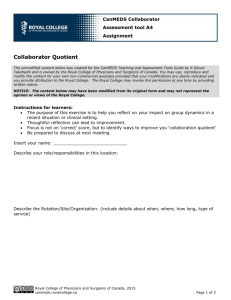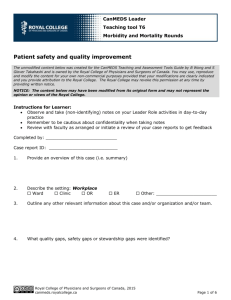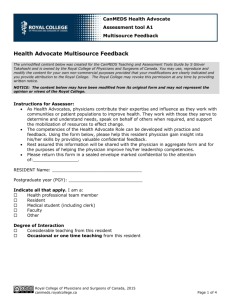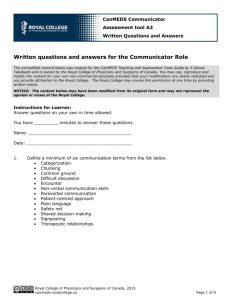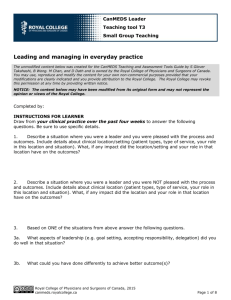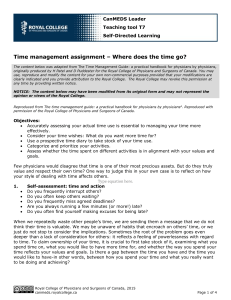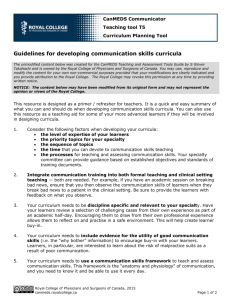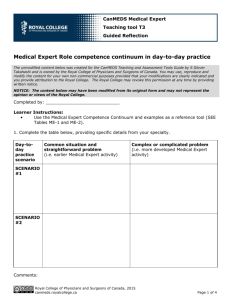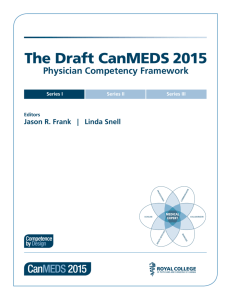MS Word - CanMEDS Interactive
advertisement
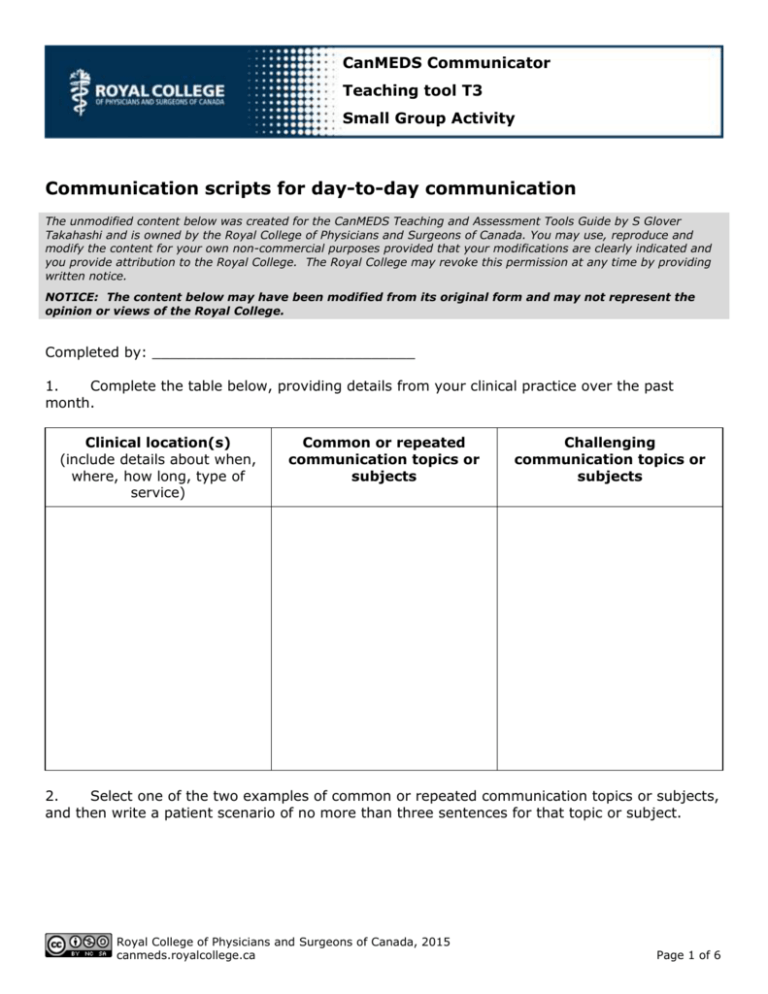
CanMEDS Communicator Teaching tool T3 Small Group Activity Communication scripts for day-to-day communication The unmodified content below was created for the CanMEDS Teaching and Assessment Tools Guide by S Glover Takahashi and is owned by the Royal College of Physicians and Surgeons of Canada. You may use, reproduce and modify the content for your own non-commercial purposes provided that your modifications are clearly indicated and you provide attribution to the Royal College. The Royal College may revoke this permission at any time by providing written notice. NOTICE: The content below may have been modified from its original form and may not represent the opinion or views of the Royal College. Completed by: ______________________________ 1. Complete the table below, providing details from your clinical practice over the past month. Clinical location(s) (include details about when, where, how long, type of service) Common or repeated communication topics or subjects Challenging communication topics or subjects 2. Select one of the two examples of common or repeated communication topics or subjects, and then write a patient scenario of no more than three sentences for that topic or subject. Royal College of Physicians and Surgeons of Canada, 2015 canmeds.royalcollege.ca Page 1 of 6 CanMEDS Teaching and Assessment Tools Guide Communicator teaching tool T3 3. You will be drafting a communication script for part of the scenario you just wrote. First, choose one or two communication skills tasks from the six listed below. Then, fill out the corresponding row(s) in the table for your scenario. Outline the core content used to discuss common or challenging communication scenarios; for verbal communication, you may wish to include some key phrases that you find helpful. 1. Initiating the session 2. Gathering information 3. Explanation and planning Communication skills taska Potential script wording 4. Closing the session 5. Providing structure 6. Building the relationship Content skills to highlight 1. Initiating the session 2. Gathering information 3. Explanation and planning 4. Closing the session 5. Building the relationship 6. Providing structure Royal College of Physicians and Surgeons of Canada, 2015 canmeds.royalcollege.ca Page 2 of 6 CanMEDS Teaching and Assessment Tools Guide Communicator teaching tool T3 T3. SAMPLE SCRIPT #1: Breaking bad news – “The driving talk” The unmodified content below was created for the CanMEDS Teaching and Assessment Tools Guide by S Glover Takahashi and is owned by the Royal College of Physicians and Surgeons of Canada. You may use, reproduce and modify the content for your own non-commercial purposes provided that your modifications are clearly indicated and you provide attribution to the Royal College. The Royal College may revoke this permission at any time by providing written notice. NOTICE: The content below may have been modified from its original form and may not represent the opinion or views of the Royal College. SCENARIO You’ve just examined a young woman with a sensory motor peripheral polyneuropathy with significant arm and leg weakness and poor proprioception in the lower legs. You’re concerned about her ability to drive, and you need to discuss this. She was referred to you for the leg and arm weakness, so she’s not expecting to discuss her driving ability. SKILLS FOCUS of this script: Explanation and planning (Communication skills task #3) Closing the session (Communication skills task #4) Building the relationship (Communication skills task #5) Communication Potential script wording CONTENT skills to skills taska and other tips highlight PROCESS skills to highlight 3. Explanation and planning Assess patient’s starting point Organize information into discrete chunks Regular chunks and checks Pick up and respond to verbal and nonverbal cues Check with patient to determine if she accepts the information and if her concerns are being addressed Begin by asking how the Highlight what is patient perceives her needed for safe driving ability driving: good eyes, Provide an assessment brain, and strong of the patient’s function arms and legs in plain language using Summarize the the content above in the weakness and scenario sensory loss so the Ask if the patient feels patient has a good her driving is safe, and understanding of depending on the deficits situation, ask “what do Explain that it is the you think I’m going to Ministry of say about your driving?” Transportation that Pause regularly to gauge makes the final reaction to the decision about ability information to drive; however, Check for body language physicians are throughout the mandated (in some interaction (the patient provinces) to report may say little verbally concerns about but express a lot of driving safety if the emotion through eye patient has a contact, posture, etc.) condition that may Allow time for questions affect their ability to drive Royal College of Physicians and Surgeons of Canada, 2015 canmeds.royalcollege.ca Page 3 of 6 CanMEDS Teaching and Assessment Tools Guide Communicator teaching tool T3 4. Closing the session Provide support by offering to explore other transportation options Finish by asking if the patient has further questions about what was said or the next steps Offer to discuss again once the patient has had time to reflect on the information further (some will be stunned enough by the interaction that they say very little, but then a few days later, there will be a call). Provide permission for a followup call to happen with an agreement to discuss again (this is an example of forward planning) Contract with the patient for next steps Do a final check that the patient agrees with the plan and ask if there are any other questions 5. Building the relationship Provide the content in an empathic and sensitive manner Respond with empathy at the reaction (sometimes can be quite forceful and negative; allow the patient to express her emotion). For example, I know the driving was not a topic that you were expecting to discuss with me today. I can see that the information that I have given you is unexpected. This builds on picking up on verbal and non-verbal cues from above and shows the learner is acknowledging the emotion and is reflecting back understanding to the patient Uses empathy to communicate understanding and appreciation of the patient’s predicament (overtly acknowledges patient’s views and feelings) Royal College of Physicians and Surgeons of Canada, 2015 canmeds.royalcollege.ca Page 4 of 6 CanMEDS Teaching and Assessment Tools Guide T3. Communicator teaching tool T3 SAMPLE SCRIPT #2: Sharing information – “Test results and consent” The unmodified content below was created for the CanMEDS Teaching and Assessment Tools Guide by S Glover Takahashi and is owned by the Royal College of Physicians and Surgeons of Canada. You may use, reproduce and modify the content for your own non-commercial purposes provided that your modifications are clearly indicated and you provide attribution to the Royal College. The Royal College may revoke this permission at any time by providing written notice. NOTICE: The content below may have been modified from its original form and may not represent the opinion or views of the Royal College. SCENARIO You are seeing Mrs. X for a follow-up appointment to discuss the results of a biopsy, which are positive to cancer, and to plan next steps. SKILLS FOCUS of this script: Initiating the session (Communication skills task #1) Gathering information (Communication skills task #2) Explanation and planning (Communication skills task #3) Closing the session (Communication skills task #4) Communication skills taska Potential script wording and other tips CONTENT skills to highlight 1. Initiating the session “Good to see you back, Mrs. X, I can imagine it’s been a long two weeks.” Will vary by specialty “As you know, the purpose of today’s appointment is to discuss the results of your biopsy. I’m going to start there, discuss what they mean, answer any questions you may have about the results, then move to discussing next steps. Does that sound reasonable?” PROCESS skills to highlight Have results ready Provide privacy Sit down Make eye contact Greet patient with empathy for the wait Set the agenda Provide the result in plain language immediately. Pay attention to reaction Pause after presenting the result and meaning Empathetically acknowledge reaction “Unfortunately the biopsy showed … which means …” “What are your thoughts at this point?” 2. Gathering information “I need to get some further history and to ask about your preferences so we can come up with next steps that work for you.” Will vary by specialty Royal College of Physicians and Surgeons of Canada, 2015 canmeds.royalcollege.ca Signpost – provide rationale for needing to ask further questions Page 5 of 6 CanMEDS Teaching and Assessment Tools Guide 3. Explanation and planning “Based on the results and your history, we have two surgical treatment choices: a lumpectomy or a mastectomy. I am going to describe each procedure, and discuss the risks and benefits. I’ll start with the lumpectomy and then move to the mastectomy.” Communicator teaching tool T3 Will vary by specialty Categorize Draw pictures Chunk and check Use plain language Pause frequently for questions. “A lumpectomy is a surgical procedure where they go in and remove the cancerous tissue. On the day of surgery ..[details]…. “Do you have any more questions before I move on to talk about the risks and benefits of this choice?” 4. Closing the session “Okay, let’s summarize the plan to ensure we are both on the same page. Can you repeat in your own words the next steps?” Will vary by specialty Repetition (Repeat OR ask the patient to repeat the plan) Safety net “Let’s talk about what to do if you have not heard back about a surgical date in two weeks or feel you are experiencing changes that are important for me to know.” Kurtz S, Silverman J, Draper J. Teaching and learning communication skills in medicine. 2nd ed. London: Radcliffe Publishing. Copyright © 2005. Reproduced by permission of Taylor & Francis Books UK. a Royal College of Physicians and Surgeons of Canada, 2015 canmeds.royalcollege.ca Page 6 of 6
